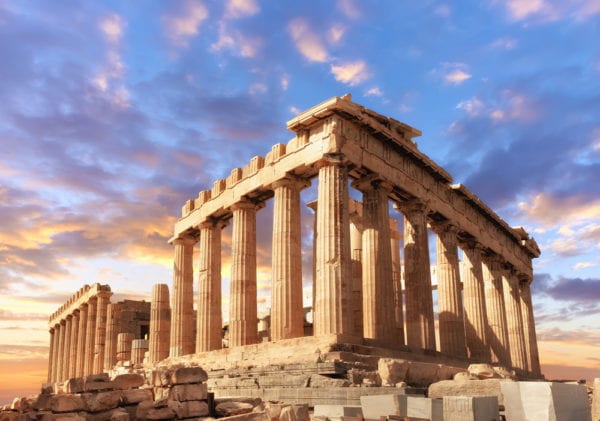A brief overview of Ancient Greek architecture
A brief overview of Ancient Greek architecture
A brief overview of Ancient Greek architecture
-
Hannah
-
Hannah

My interest in ancient civilisations began with the stories I was told by my parents and governess in childhood – but it was cemented by glimpses of the physical remains of those civilisations: the Pyramids at Giza, the Colosseum in Rome, the many ruins on the Greek island of Delos, birthplace of Apollo and Artemis.
My travels as a young woman infused me with a fascination for archaeology, which inspired my latest novel, Aphrodite’s Tears. The heroine, Oriel, is an archaeologist, tasked with overseeing the exploration of an old wreck off the shore of the little island of Helios. Over the years, her career has taken her all over the world, and she has explored all kinds of artefacts and ruins, but she has a particular interest in the Ancient Greeks, who left behind a rich heritage that is still being unearthed to this day.
My trips to Greece and the Greek islands and my own research formed the foundations for Aphrodite’s Tears. I recall that when I visited my first Ancient Greek site, at Olympia, I felt quite overwhelmed – where does one start, trying to interpret all the ruins? A friend told me to focus on just two aspects of the ancient architecture: the types of buildings commonly built and the styles used for the design. I followed this advice, and found it really opened up my experience of visiting ruins and reading about them. I hope you find the following overview helpful too.
Typical buildings of the Ancient Greeks
The buildings that have survived to this day (albeit as ruins, though many are remarkably intact) date back as far as 600 BC. The two most important constructions were the temples, for worship of the Greek gods and goddesses, and the open-air theatre.
The temple was built on high ground – as Aristotle wrote, ‘the site should be a spot seen far and wide, which gives good elevation to virtue and towers over the neighbourhood’. It was part of the acropolis, the religious area of the town, and the altar was situated outside, before the temple.

The Temple of Athena, Delphi
The theatre was built on a hillside just outside town, with tiered seating curved around the orchestra – the stage area where actors performed. The theatre was also the site for public meetings.
A Greek town would often have a public square, called the agora, which was surrounded by a colonnade (a row of evenly spaced columns supporting a roof, an entablature, or arches), called the stoa. The town council were housed in the bouleuterion, also used as the court house; the dead were entombed in the mausoleum.
Bigger towns also had a gymnasium, where the men would meet and socialise, a hippodrome for horse racing and a stadium for athletic events.
Home was the oikos, a simple house, originally with just two rooms and a pronaos, a porch.
The orders of Ancient Greek architecture
The temples and other public buildings were built to impress – grand structures constructed to honour deities and to foster civic pride. In studying Greek architecture, the Roman writer Vitruvius divided the architectural style into three ‘orders’.
* The Doric Order was founded in mainland Greece and spread to colonies in Italy and Sicily. It was characterised by a quite plain and sturdy column, with a thick square on top.
* The Ionian Order developed in the Greek cities of Ionia, in Asia Minor and the Aegean Islands. This style was a little more decorative, and was made distinctive by the scroll-like design on the column.
* The Corinthian Order wasn’t used so much by the Greeks but was popularised by the Romans. This order was elaborate in style, with acanthus leaf ornamentations.

Each of these orders had a major impact on the development of architecture in the Roman Empire and ultimately across the West. Successive generations found beauty in the strength, symmetry, balance and proportions of this classic architecture.
The Parthenon on the Acropolis in Athens – a temple devoted to the goddess Athena – is commonly recognised as the ultimate example of Ancient Greek architecture.

I’ve been to the Parthenon in 1971. Whenever I am reminded of Athens I visualize sitting on the Mars Hill of Acts 17 in the Bible thinking about St. Paul and at the same time looking across to the Acropolis. http://uploads.disquscdn.com/images/c044511b951b8dd50fcb5a2eac23b4131ae36521dda205fb4303d8dce988f23e.jpg http://uploads.disquscdn.com/images/7c138c56541958dbf2e81ce4f48aa2c96d9c9576beb36d6c27bff18e640e8c52.jpg
The similar architecture of the Roman Era always evokes Greece in my mind.
These two pictures are of ruins of two different forums of Roman era in Tarragona, Spain